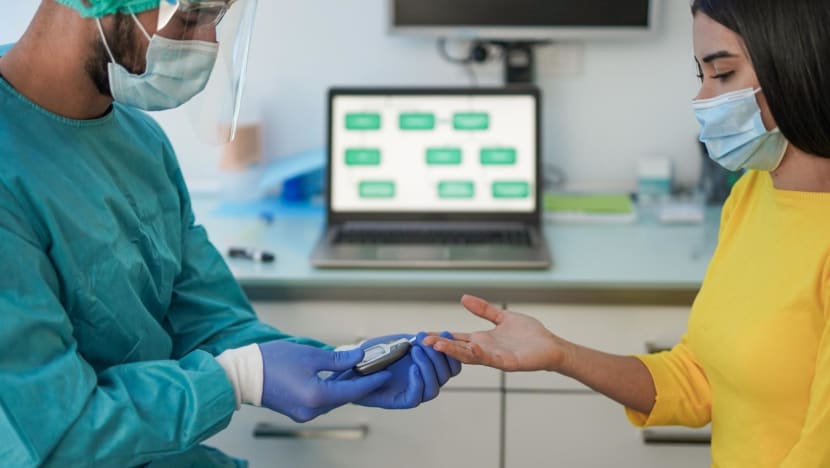New tools and approaches to fight the pandemic of diabetes and its complications
In Southeast Asia, 90 million adults are living with diabetes – but there’s hope for a better tomorrow for diabetes care.

Together with new drug therapies, modern technology – such as intermittently scanned glucose monitoring – could help change the landscape of glycaemia management. Photos: Shutterstock
There’s a pandemic in plain sight sweeping across the world. It was responsible for 6.7 million deaths in 2021 – and it’s not COVID-19.
Instead, it’s Type 2 diabetes mellitus – the most common form of diabetes. The International Diabetes Foundation (IDF) estimates that around 537 million adults globally are currently living with diabetes – a number that’s projected to increase to 643 million by the year 2030, and 783 million by 2045.
According to the IDF Diabetes Atlas 2022, Southeast Asia is home to 90 million adults with diabetes, and this is expected to rise to 113 million by 2030. Of the 90 million, 46 million are undiagnosed, unaware that they have this disorder. Delays in the diagnosis of diabetes result in prolonged uncontrolled hyperglycaemia (high blood sugar), which in turn causes significant diabetes-related complications.
These figures paint a sobering picture of a disease that is spiralling rapidly, with severe consequences for global health and healthcare costs if it is not brought under control.
THE RISKS OF TYPE 2 DIABETES
In Type 2 diabetes, the body’s response to insulin – a pancreatic hormone that regulates the amount of glucose (sugar) in your bloodstream – is impaired. This results in increased blood glucose levels.
The pancreas attempts to control the situation by producing more insulin, but eventually becomes exhausted and produces less insulin over time, causing even higher blood glucose levels. This prolonged hyperglycaemia can lead to permanent nerve damage in the patient’s hands and feet, damage to eyesight, and life-threatening conditions like heart disease, stroke and kidney impairment.
According to the American Diabetes Association, the rising prevalence of Type 2 diabetes is linked to obesity. In Southeast Asia, rising incomes have caused lifestyle and dietary changes that result in a higher risk for diabetes.
Said Dr Siew Pheng Chan, Emeritus Professor, University of Malaya, Kuala Lumpur, Malaysia: “It has been hypothesised that developing countries witnessing economic booms characterised by rapid changes from traditional to Westernised high-calorie-dense diets and active to sedentary lifestyles are most at risk of a Type 2 diabetes epidemic by 2030.”
Adding that access to medication can be challenging in Asia, Dr Chan pointed out: “The increasing prevalence of diabetes, combined with a growing global shortage of healthcare professionals, necessitates the need to develop new approaches to diabetes care delivery to expand access to care, lessen the burden on people with diabetes, improve efficiencies, and reduce the unsustainable financial liability on health systems and payers.”
Dr Ma Cecille Anonuevo Cruz of St Frances Cabrini Medical Center, Philippines, also cautioned about the snowball effect of the diabetes epidemic. “In diabetes, a delay in diagnosis, control, identification of comorbidities and initiation of preventive strategies can lead to more complications,” she said. “It is important to recognise that delayed or limited access to care frequently affects those who also have limited financial resources and social support, who are then more likely to have a higher risk of diabetes-related complications and mortality.”
KEY ADVANCES IN DIABETES MANAGEMENT

Dr Dicky L Tahapary, from Dr Cipto Mangunkusumo National Referral Hospital in Jakarta, Indonesia, said that the introduction of large-scale cardiovascular outcome trials has greatly impacted the way Type 2 diabetes is diagnosed and treated.
According to Dr Chan, these cardiovascular outcome trials and renal outcome trials in Type 2 diabetes have shown that some classes of medication could lessen the risks of cardiovascular and renal complications in addition to lowering glucose levels.
“These results are exciting and hold significant promise for people with Type 2 diabetes, showing that heart attacks, strokes and death from cardiovascular disease, and progression to renal failure can be significantly reduced,” she said, adding that these advances have shifted the paradigm of Type 2 diabetes management today.
Added Dr Cruz: “Screening for diabetes complications and cardiovascular risk factors on first consultation and throughout the patient’s follow-up will help guide the selection of treatment options for the patient and, when necessary, facilitate timely referral to appropriate subspecialty care.”
Another important advance in diabetes management is the use of real-world evidence in addition to randomised controlled trials that provide more information on the safety and efficacy of diabetes medications.
“Many questions about a drug remain unanswered at the time of approval, such as optimal dosing regimen, longer-term outcomes and outcomes in various sub-populations,” explained Dr Chan. “Data on real-life comparative effectiveness is required to inform clinician and payer decisions. To mitigate this gap, real-world data and real-world evidence are playing an increasingly important role in healthcare decisions. Medical product developers are also using both to support clinical trial designs and observational studies to generate new, innovative treatment approaches in the management of Type 2 diabetes.”
A PATIENT-CENTRIC APPROACH
Alongside these advances in medication development, our understanding of hyperglycaemia has changed. Previously, hyperglycaemia was measured by the HbA1c test, which displays a patient’s average blood sugar levels over a few months. HbA1c refers to haemoglobin A1C, a form of haemoglobin that is elevated when a patient has sustained hyperglycaemia. The higher one’s glucose levels, the higher the HbA1c.
Said Dr Chan: “Together with new drug therapies, modern technology – such as intermittently scanned glucose monitoring and continuous glucose monitoring – could help change the landscape of glycaemia management based on HbA1c in favour of a more holistic approach that considers all the different aspects of diabetes.”
Dr Tahapary highlighted that the treatment target and options need to be thoroughly discussed between physician and patient to reach a shared decision.
This shared decision-making is borne out of a detailed understanding of a patient’s condition, according to Dr Cruz. “We look at the patient’s diseases and complications, resources, preferences, perceptions and personal goals, and adapt our management plans to better suit them,” he said.
In Singapore, patient-centred care takes the form of empowering patients during the decision-making process through a communication-focused model in polyclinics and hospitals, as well as community-based programmes that educate patients and empower them to self-manage their own chronic conditions.
“Evidence has shown that patient-centred care could be associated with improved diabetes self-management, quality of life and adherence in patients with diabetes,” said Dr Chan.
With new therapies and a holistic approach to fight diabetes, there is hope on the horizon for the millions of people living with the disease.















